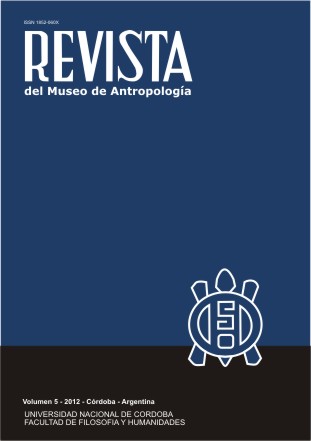Tango is back: “Tango Argentino” and the narratives about the comeback of the dance in Buenos Aires
DOI:
https://doi.org/10.31048/1852.4826.v5.n1.9127Keywords:
tango, dance, storytelling, stories about the pastAbstract
At present, tango dance in Buenos Aires has aroused renewed interest as a local practice and become a valuable resource for economic development and tourism promotion in the city. In this paper we will analyze the narratives -reproduced by milongueros, tango dancers and those close to tango- which explain why tango “has made a comeback” to be a culturally legitimate and recognized practice in the city from the 80s onwards. On the basis of this process of revival of tango danced, we will address the construction of a dominant story linked to a show called “Tango Argentino”. We will explore how this story today is the subject of legitimacy and dispute, and will observe the dialogical relations established with different narratives and how they interact with historical or previous utterances. From these tango narrative constructs about past and present, we will question the confrontation of meanings around the practice of dancing in Buenos Aires.Downloads
References
Azzi, M.1991. Antropología del tango. Los protagonistas, Olavaria, Buenos Aires.
Bajtín, M.1992. [1979] El problema de los géneros discursivos. Estética de la creación verbal, pp. 248-293, Siglo XXI, México.
Bourdieu, P. 1990. Algunas propiedades de los campos. Sociología y Cultura, pp. 135-141, Grijalbo, México.
Bourdieu, P. 2007. El sentido práctico, Siglo XXI, Buenos Aires.
Briggs, C., R. Bauman. 1996. Género, intertextualidad y poder social. Revista de Investigaciones Folclóricas 11: 78-108.
Carozzi, M. 2005. La edad avanzada como valor en el tango bailado en Buenos Aires. Revista Cuestiones Sociales y Económicas, III (6): 73-86.
Cibotti, E. 2009. Del encanto al desencanto de una élite, en clave de tango. En Lencina, T., García Brunelli, O., Salton, R. (comp.), Escritos sobre tango. En el Río de la Plata y en la diáspora, pp. 41-54, Centro ‘feca, Buenos Aires.
Chertudi, S. 1967. El cuento folklórico. CEAL, Buenos Aires.
Del Mazo, M., A. D’Amore. 2001. Quién me quita lo bailado. Juan Carlos Copes: una vida de tango, Corregidor, Buenos Aires.
Falcoff, L. 2008. Historia del tango escénico. En Historia general de la danza en la Argentina, pp. 371-391, Fondo Nacional de las Artes, Buenos Aires.
Garramuño, F. 2007. Modernidades primitivas. Tango, Samba y Nación, Fondo de Cultura Económica, Buenos Aires.
Grignon, C., J. Passeron. 1991. Lo culto y lo Popular. Miserabilismo y populismo en sociología y en literatura, Nueva Visión, Buenos Aires.
Hymes, D. 1986 [1972]. Models of the Interaction of Language and Social Life. En Gumperz, John y Dell Hymes (eds.), Directions in Sociolinquistics: The Ethnography of Communication, pp. 35-71, Basil Blackwell, Oxford/Nueva York.
Lamas, H., E. Binda. 2008. El tango en la sociedad porteña 1880- 1920, Abrazos, Stuttgart.
Langdon, E. J. 1999. A fixacao da narrativa: do mito para a poetica de literatura oral. Revista Horizontes Antropologicos 12: 13-36.
Lévi-Strauss, C. 1987. La eficacia simbólica. Antropología Estructural, pp. 211-227, Paidos, Barcelona.
Maronese, L. 2008. De milongas y milonguer@s. Comisión para la Preservación del Patrimonio Cultural de la Ciudad Autónoma de Buenos Aires.
Morel, H. 2009. El giro patrimonial del tango: políticas oficiales, turismo y campeonatos de baile en la Ciudad de Buenos Aires. Cuadernos de Antropología Social 30: 155-172.
Morel, H. 2011a. “Milonga que va borrando fronteras”. Las políticas del patrimonio: un análisis del tango y su declaración como Patrimonio Cultural Inmaterial de la Humanidad. Intersecciones en Antropología 12: 163-176.
Morel, H. 2011b. “Políticas culturales y performance en los procesos patrimoniales. Los casos del tango y el carnaval en la ciudad de Buenos Aires”. Facultad de Filosofía y Letras, UBA, Argentina. Tesis de doctorado, Biblioteca de la Facultad de Filosofía y Letras.
Ochs, E. 2000. Narrativa. En Van Dijk, T. (comp.), El discurso como estructura y proceso. Estudios del discurso: introducción multidisciplinaria, pp. 271-303, Gedisa, Barcelona.
Pelinski, R. 2000 [1981]. Decir el tango. Invitación a la Etnomusicología. Quince fragmentos y un tango, pp. 26-42, Akal, Madrid.
Pelinski, R. 2009. Tango nómade. Una metáfora de la globalización. En Lencina, T., García Brunelli, O., Salton R. (comp.), Escritos sobre tango. En el Río de la Plata y en la diáspora, pp. 65-129, Centro ‘feca, Buenos Aires.
Pujol, S. 1999. Historia del baile. Emecé. Buenos Aires.
Rabossi, F. 1997. “La cultura y sus políticas. Análisis del Programa Cultural en Barrios”. Facultad de Filosofía y Letras, UBA, Argentina. Tesis de Licenciatura, Biblioteca de la Facultad de Filosofía y Letras.
Rosaldo, R. 1989. Análisis de la narrativa. Cultura y Verdad. Nueva propuesta de análisis social, pp. 123-136, Grijalbo, México.
Savigliano, M. 1995. Tango and the political economy of passion. Boulder, Colorado.
Vega, C. 2007. Estudios para los orígenes del tango argentino. Coriún Aharonián (Editor), Universidad Católica Argentina, Buenos Aires.
Downloads
Published
Issue
Section
License
Those authors who have publications with this Journalaccept the following terms:
a. Authors will retain their copyrights and guarantee the journal the right of first publication of their work, which will be simultaneously subject to the Creative Commons Attribution License (Licencia de reconocimiento de Creative Commons) that allows third parties to share the work as long as its author and his first publication in this journal.
b. Authors may adopt other non-exclusive licensing agreements for the distribution of the version of the published work (eg, deposit it in an institutional electronic file or publish it in a monographic volume) provided that the initial publication in this journal is indicated.
c. Authors are allowed and recommended to disseminate their work on the Internet (eg in institutional telematic archives or on their website) before and during the submission process, which can lead to interesting exchanges and increase citations of the published work. (See The Effect of Open Access - El efecto del acceso abierto)












